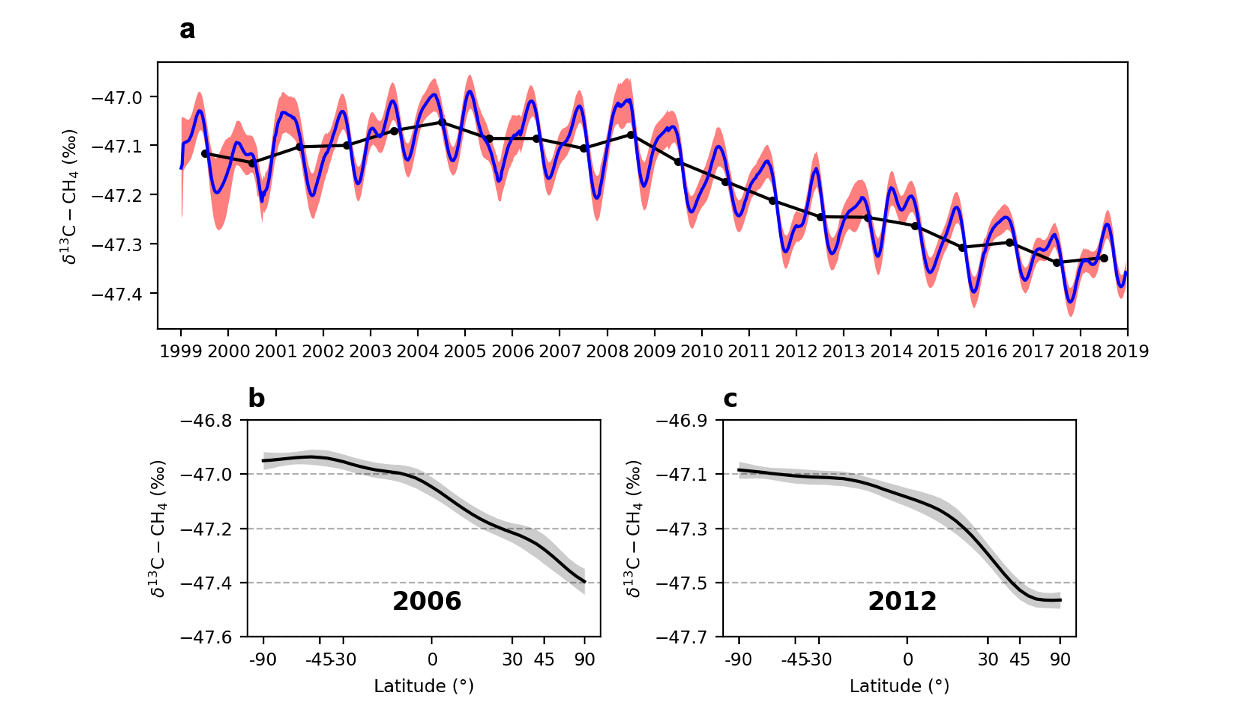Atmospheric d13C-CH4 data from the Institute of Arctic and Alpine Research (INSTAAR)at the University of Colorado, Boulder in cooperation with NOAA Global MonitoringLaboratory
Authors- *Sylvia E. Michel, INSTAAR, University of Colorado
- Bruce H. Vaughn, INSTAAR, University of Colorado
- Pieter Tans, NOAA/GML
- Kirk Thoning, NOAA/GML
- Xin Lan., University of Colorado/CIRES, NOAA/GML
* corresponding author for atmospheric data. Email: sylvia.michel@colorado.edu
Abstract
NOAA's Cooperative Global Air Sampling Network has been monitoring the abundance of atmospheric CH4 since 1983. Weekly flask-air samples are collected from the network sites and sent to NOAA in Boulder, Colorado for CH4 analysis. Since 1998, a subset of NOAA's flask-air samples is analyzed for the ratio of stable carbon isotopes of CH4 ( 13C/ 12C), denoted by δ13C-CH4 , at the Institute of Arctic and Alpine Research (INSTAAR), University of Colorado, Boulder. The methane mole fraction data show decadal and interannual variations in the growth rate of CH4 : a large rise in CH4 burden in the 1980s and 1990s, a stabilization period between 1999 to 2006, followed by a period of renewed increase since 2007. The driver behind these variations are still unclear. Around the same time that the renewed CH4 increase started, δ13C-CH4 started to decrease after two centuries of increase [Ferretti et al., 2005; and data presented here]. Since different CH4 sources have distinct δ13C-CH4 signatures over large spatial scales, atmospheric δ13C-CH4 data can provide strong constraints on CH4 emissions and sinks.
This atmospheric δ13C-CH4 dataset was compiled for the study of 'Improved constraints on global methane emissions and sinks using δ13C-CH4 ' (Lan et al. 2021) to provide observation-based global mean δ13C-CH4 and their latitudinal gradients from the Marine Boundary Layer surface (https://www.esrl.noaa.gov/gmd/ccgg/mbl/mbl.html). We also estimate realistic and robust uncertainties for them, which include uncertainties related to the distribution of sampling sites (network), synoptic variability in air masses (atmospheric) and the possibility of unknown bias in measurement (bias). Details regarding the methods used are documented in Lan et al. (2021) (see following citation). δ13C-CH4 signatures from different CH4 sources are often used together with atmospheric δ13C-CH4 data to better allocate different CH4 emissions, as in Lan et al. (2021). An updated version of the δ13C-CH4 source signatures is also complied by Lan et al. (2021) and available here: Source signature inventory 2020
Product information:
This database includes:
- Global mean atmospheric δ13C-CH4 for 1999-2018 and uncertainty
- Yearly latitudinal gradients of δ13C-CH4 for 1999-2018
- Uncertainty of yearly latitudinal gradients for the same period
- Site specific δ13C-CH4 data
- A readme file describing the data files

Fair Use Statement
These data are made freely available to the public and the scientific community in the belief that their wide dissemination will lead to greater understanding and new scientific insights. To ensure that GML receives fair credit for their work please include relevant citation text in publications. We encourage users to contact the data providers, who can provide detailed information about the measurements and scientific insight. In cases where the data are central to a publication, co-authorship for data providers may be appropriate.
Citation
Lan, X., Basu, S., Schwietzke, S., Bruhwiler, L. M. P., Dlugokencky, E. J., Michel, S. E., Sherwood, O. A., Tans, P. P., Thoning, K., Etiope, G., Zhuang, Q., Liu, L., Oh, Y., Miller, J. B., Petron, G., Vaughn, B. H., Andrews, A., Crippa, M.: Improved constraints on global methane emissions and sinks using d13C-CH4, Global Biogeochemical Cycles, 35, https://doi.org/10.1029/2021GB007000
Database DOI: https://doi.org/10.15138/79jq-qc24
ATTENTION! When you download a data product, an automatic e-mail containing your contact information will be sent to contributing data providers.
Please DO NOT re-distribute this product. It is freely available to all users from this site.
Please complete the form below and press "Submit". You will receive an immediate, automated e-mail with access instructions.
